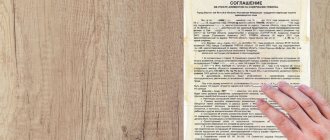ST 150 of the Criminal Code of the Russian Federation.
1. Involving a minor in committing a crime through promises, deception, threats or in any other way, committed by a person who has reached the age of eighteen, is punishable by imprisonment for a term of up to five years.
2. The same act committed by a parent, teacher or other person who is charged by law with the responsibility for raising a minor is punishable by imprisonment for a term of up to six years, with or without deprivation of the right to hold certain positions or engage in certain activities for a term of up to three years. such.
3. Acts provided for in parts one or two of this article, committed with the use of violence or with the threat of its use, are punishable by imprisonment for a term of two to seven years, with or without restriction of freedom for a term of up to two years.
4. Acts provided for in parts one, two or three of this article, related to the involvement of a minor in a criminal group or in the commission of a grave or especially grave crime, as well as in the commission of a crime motivated by political, ideological, racial, national or religious hatred or enmity, or motivated by hatred or hostility towards any social group - is punishable by imprisonment for a term of five to eight years, with or without restriction of freedom for a term of up to two years.
Commentary to Art. 150 Criminal Code
1. The objective side is expressed in the involvement of a minor in the commission of a crime through promises, deception, threats or other means.
Involving a minor in the commission of a crime constitutes incitement. However, in the case where the subject of the involvement of a minor is an adult, the legislator considered it necessary to distinguish it as an independent crime. Thus, the involvement of a minor in the commission of a crime turns into a special type of incitement, but does not acquire any other quality different from incitement.
2. In Part 1 of Art. 150 of the Criminal Code contains an open list of methods of involvement: promise, deception, threat, other methods.
3. The corpus delicti is formal. The moment of its completion is associated with the commission of an act - involvement as a complex (resultative) action, covering the result in the form of the emergence of a desire in a minor to commit a crime and the realization of the desire in full or at least partially; It is this position, after much debate, that is reflected in paragraph 42 of the Resolution of the Plenum of the Supreme Court of the Russian Federation of February 1, 2011 No. 1 “On the judicial practice of applying legislation regulating the specifics of criminal liability and punishment of minors.”
4. If a minor has committed a crime in which he has become involved, the perpetrator must be held jointly liable: for involvement in the commission of a crime under Art. 150 of the Criminal Code and for incitement to a crime in which he involved a minor, and if he himself participated in the commission of a crime - as a co-perpetrator of this crime.
5. From the subjective side, the intent of the perpetrator must also include awareness of the age of the person involved. A subject is any person over 18 years of age.
6. Part 2 art. 150 of the Criminal Code provides for criminal liability of parents, teaching staff and other persons who are charged by law with the responsibility for raising a minor. Other persons responsible for education are medical, social workers, psychologists and other specialists.
7. The concept of “violence” (Part 3 of Article 150 of the Criminal Code) includes violence that is not dangerous to life and health, as well as causing minor, moderate harm to health and torture without qualifying criteria; infliction of grievous bodily harm and torture under aggravating circumstances are qualified in conjunction with Art. 150 CC. The threat of violence implies mental influence on a minor. It can be anything, including a threat to kill or cause serious harm to the health of a minor.
8. In part 4 art. 150 of the Criminal Code provides for three special qualifying criteria: 1) involvement of a minor in a criminal group (a group of persons by prior conspiracy, an organized group or a criminal community); 2) in the commission of a grave or especially grave crime; 3) committing a crime based on political, ideological, racial, national or religious hatred or enmity, or based on hatred or enmity against any social group.
How to account for low-value fixed assets
An organization can exclude individual objects from fixed assets if it establishes a cost limit in its accounting policy. It is determined by the organization itself, taking into account materiality (clause 5 of FSBU 6/2020). FAS 6/2020 does not apply to fixed assets that cost less than this limit. The cost of low-value fixed assets is charged to period expenses.
However, it is necessary to organize the accounting of these assets. The organization develops the methodology itself and reflects it in its accounting policies. For example, you can account for low-value fixed assets in an off-balance sheet account or in a special statement.
The new standard does not provide for any amount restrictions. Now you can set a limit for fixed assets in any amount. In particular, if a company operates on OSNO and wants to minimize tax differences, it can set a limit of 100 thousand rubles. as in tax accounting.
The limit for fixed assets can be set not only as a fixed amount, but also as a percentage of the total value of this type of asset (clause 5 of the BMC recommendation No. R-126/2021-KpR dated March 29, 2021). For example, you can determine that a group of fixed assets is insignificant as long as its share is less than 5% of the total cost of fixed assets owned by the company.
At the same time, according to the recommendation of the Ministry of Finance, a limit should be set not for the group, but for each fixed assets object separately (letter dated August 25, 2021 No. 07-01-09/68312).
The company can use any of these options by reflecting it in its accounting policies.
Second commentary to Art. 150 of the Criminal Code of the Russian Federation
1. The involvement of a minor in the commission of a crime should be understood as actions that encourage him to participate in the commission of one or more crimes as a perpetrator or accomplice.
2. A promise means an undertaking to do something useful, material or otherwise, for a minor. Deception is creating a false impression about someone or something, misleading a minor. The threat is expressed in the socially dangerous information impact on the psyche of a minor, in his intimidation. Another method involves a wide range of influences on the psyche of a minor, prompting him to commit a crime: revenge, bribery, education in the spirit of “thieves’ romance,” etc.
3. The subjective side is characterized by direct intent.
4. The subject of the crime is a person who has reached the age of 18 years.
5. In addition to blood parents (including the father, recognized as a parent in accordance with Article 49 of the Family Code), the stepfather, stepmother, as well as adoptive parents may be responsible. Another person is understood to be a guardian, trustee, representative of a specialized state body exercising educational functions in relation to a minor and monitoring his behavior, etc.
6. Physical violence is characterized by beatings, causing minor or moderate harm to health; mental impact - threat of harm to health of varying severity, murder.
7. A criminal group should be understood as a group of persons, a group of persons by prior conspiracy, an organized group and a criminal community (criminal organization).
For the commission of a crime based on political, ideological, racial, national or religious hatred or enmity, or based on hatred or enmity against any social group, see the commentary to Art. 105 of the Criminal Code.
Depreciation of fixed assets
General rules for calculating depreciation
Now all legal entities that are subject to the new standard - both commercial and non-profit organizations - must calculate depreciation on fixed assets. As before, there is no need to depreciate objects whose properties do not change over time, for example, land plots.
The new standard added another group of fixed assets that are not subject to depreciation. This is investment property, which the organization accounts for at a revalued value (clause 28 of FSBU 6/2020).
In general, depreciation should begin to be calculated from the date the asset is recognized in accounting, and should be completed from the date of its write-off. But the organization has the right to begin and complete the calculation of depreciation from the 1st day of the month following, respectively, the month of recognition or write-off of the object (clause 33 of FSBU 6/2020).
To apply an alternative method of calculating depreciation from the 1st day of the next month, you need to reflect this provision in the accounting policy. This option will allow you to avoid deviations between accounting and tax accounting, but only if the object was put into operation in the same month as it was accepted for accounting.
Now depreciation must be calculated regardless of the actual use of the fixed asset, including during long periods of downtime or conservation.
According to the new rules, depreciation does not have to be calculated monthly. This can be done during the reporting period. But if the organization maintains management accounting and determines the financial result every month, then it is logical to continue to calculate depreciation monthly.
Damping elements
When accepting an item of fixed assets for accounting, the organization must determine its liquidation value, useful life and method of calculating depreciation. Together these measures are called depreciation elements.
Liquidation value is the material benefit that an organization expects to receive from the disposal of an object at the end of its useful life (clause 30 of FSBU 6/2020).
the useful life of each object based on the expected operating conditions, expected physical wear and tear and obsolescence, as well as plans for replacing and upgrading the operating system (clause 9 of FSBU 6/2020).
Depreciation according to the new standard must be calculated so that by the end of its useful life the book value of the object becomes equal to its liquidation value (clause 32 of FSBU 6/2020). If the book value reaches the liquidation value or falls below it, for example, after revaluation, then depreciation should be suspended. Thus, fully depreciated fixed assets will now be reflected in accounting not at zero, but at liquidation value.
The liquidation value may be zero if one of the following conditions is met (clause 31 of FSBU 6/2020):
1. No material benefit is expected from disposal of the asset at the end of its useful life.
2. The stated material benefit is insignificant or cannot be determined.
The organization must choose for each group of fixed assets a depreciation method from the three depreciation methods provided for by the standard:
- linear method;
- reducing balance method;
- calculation method is proportional to the quantity of products or volume of work.
The method of calculating depreciation must be chosen so as to most accurately reflect the distribution of economic benefits from the use of an object over time (clause 34 of FSBU 6/2020).
For example, an office or warehouse building, as a rule, brings the same benefits to the organization in both the first and tenth year of operation. Therefore, a linear depreciation method must be used for the building. In this case, depreciation for each period is determined as the ratio of the difference between the book value and liquidation value to the remaining number of years of useful use (clause 35 of FSBU 6/2020).
A vehicle or machine is usually operated intensively in the first years of use, and then in a gentle mode. In such cases, one of the methods that takes into account the intensity of use should be used.
If the useful life of an object depends on the duration of operation, but within the period the intensity of operation changes, then you need to use the reducing balance method. In this case, the amount of depreciation for each subsequent year should be less than for the previous one. The organization must determine the calculation formula independently.
If it is possible to link the useful life of an object to manufactured products or work performed, you need to use a method for calculating depreciation in proportion to the number of products or volume of work. In this case, it is impossible to determine the amount of depreciation based on received revenue (clause 36 of FSBU 6/2020).
Example 1.
The organization built a modular warehouse. Its initial cost is 12 million rubles. The company plans to use it for 10 years, and then disassemble and sell the structural elements for 2 million rubles.
Depreciation for the first year of use of the warehouse will be equal to:
A1 = (12 million rubles – 2 million rubles) / 10 = 1 million rubles.
For the second year:
A2 = (12 – 2 million rubles – 1 million rubles) / 9 years = 1 million rubles.
And so on: if the company does not revise the liquidation value or other elements of depreciation, then until the end of the useful life of the warehouse it is necessary to accrue 1 million rubles for it every year. depreciation.
Suppose that after two years of using the warehouse, due to rising prices for building materials, the company decided to increase its liquidation value from 2 million rubles. up to 3 million rubles
Then depreciation for the third and subsequent years will decrease and become equal to:
A3 = (12 million rubles – 3 million rubles – 2 million rubles) / 8 = 0.875 million rubles.
Damping elements should be checked and revised if necessary. By default, this should be done once a year. You should also change the approach to calculating depreciation in cases where conditions have changed (clause 37 of FSBU 6/2020). For example, equipment has become obsolete due to the emergence of new technologies, so its salvage value needs to be reduced.








